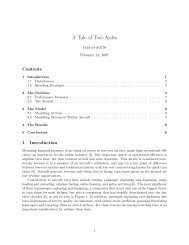Neural Models of Bayesian Belief Propagation Rajesh ... - Washington
Neural Models of Bayesian Belief Propagation Rajesh ... - Washington
Neural Models of Bayesian Belief Propagation Rajesh ... - Washington
You also want an ePaper? Increase the reach of your titles
YUMPU automatically turns print PDFs into web optimized ePapers that Google loves.
11.2 <strong>Bayesian</strong> Inference through <strong>Belief</strong> <strong>Propagation</strong> 239<br />
θ<br />
t<br />
θ<br />
t+1<br />
I(t)<br />
A<br />
I(t+1)<br />
Figure 11.2 Graphical Model for a HMM and its <strong>Neural</strong> Implementation. (A) Dynamic<br />
graphical model for a hidden Markov model (HMM). Each circle represents a node<br />
denoting the state variable θ t which can take on values 1, . . . , N. (B) Recurrent network<br />
for implementing on-line belief propagation for the graphical model in (A). Each circle<br />
represents a neuron encoding a state i. Arrows represent synaptic connections. The<br />
probability distribution over state values at each time step is represented by the entire<br />
population.<br />
A B Location<br />
Locations (L) Features (F)<br />
Intermediate<br />
Representation (C)<br />
Image (I)<br />
t<br />
B<br />
t+1<br />
I(t)<br />
Feature<br />
Coding Neurons Coding Neurons<br />
Figure 11.3 A Hierarchical Graphical Model for Images and its <strong>Neural</strong> Implementation.<br />
(A) Three-level graphical model for generating simple images containing one <strong>of</strong><br />
many possible features at a particular location. (B) Three-level network for implementing<br />
on-line belief propagation for the graphical model in (A). Arrows represent synaptic<br />
connections in the direction pointed by the arrow heads. Lines without arrow heads<br />
represent bidirectional connections.<br />
11.2.3 Hierarchical <strong>Belief</strong> <strong>Propagation</strong><br />
As a third example <strong>of</strong> belief propagation, consider the three-level graphical<br />
model shown in figure 11.3A. The model describes a simple process for generating<br />
images based on two random variables: L, denoting spatial locations,<br />
and F , denoting visual features (a more realistic model would involve a hierarchy<br />
<strong>of</strong> such features, sub-features, and locations). Both random variables<br />
are assumed to be discrete, with L assuming one <strong>of</strong> n values L1, . . . , Ln, and F<br />
assuming one <strong>of</strong> m different values F1, . . . , Fm. The node C denotes different<br />
combinations <strong>of</strong> features and locations, each <strong>of</strong> its values C1, . . . , Cp encoding a<br />
specific feature at a specific location. Representing all possible combinations is<br />
infeasible but it is sufficient to represent those that occur frequently and to map<br />
Image
















